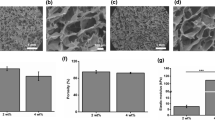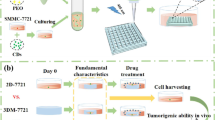Abstract
Pancreatic cancer is one of the deadliest malignancies. Three-dimensional (3D) pancreatic cancer cell models for drug screening have been established to improve treatment for pancreatic cancer. However, few studies focus on different drug responses and drug-related molecular mechanisms in various types of 3D cell models. In this study, we constructed 3D scaffold-free cell models and 3D scaffold‐based cell models of pancreatic cancer, evaluated chemotherapeutic drug responses in different 3D models, assessed clinical relevance of the models, and investigated molecular mechanisms of chemoresistance and drug pathways in different 3D models. Both types of 3D models showed resistance to chemotherapeutic drugs, and scaffold-based pancreatic cancer models could better reflect in vivo drug efficacy than 2D and scaffold-free pancreatic cancer models did. Increased cell adhesion, extracellular matrix (ECM) synthesis and drug transport were essential for drug resistance in 3D models, and anti-apoptosis might contribute to extreme chemoresistance in scaffold‐free models. Moreover, scaffold-based pancreatic cancer models were more suitable than scaffold-free models for drug pathway research.





Similar content being viewed by others
Data availability
The datasets generated during and/or analysed during the current study are available from the corresponding author on reasonable request.
References
Boutin ME, Voss TC, Titus SA et al (2018) A high-throughput imaging and nuclear segmentation analysis protocol for cleared 3D culture models. Sci Rep 8:11135
Carvalho MP, Costa EC, Miguel SP, Correia IJ (2016) Tumor spheroid assembly on hyaluronic acid-based structures: A review. Carbohydr Polym 150:139–148
Chwalek K, Bray LJ, Werner C (2014) Tissue-engineered 3D tumor angiogenesis models: potential technologies for anti-cancer drug discovery. Adv Drug Deliv Rev 79–80:30–39
De Pieri A, Rochev Y, Zeugolis DI (2021) Scaffold-free cell-based tissue engineering therapies: advances, shortfalls and forecast. NPJ Regen Med 6:18
Delle Cave D, Rizzo R, Sainz B Jr et al (2021) The Revolutionary Roads to Study Cell-Cell Interactions in 3D In Vitro Pancreatic Cancer Models. Cancers (Basel) 13:930
Devarasetty M, Mazzocchi AR, Skardal A (2018) Applications of Bioengineered 3D Tissue and Tumor Organoids in Drug Development and Precision Medicine: Current and Future. BioDrugs 32:53–68
Djomehri SI, Burman B, Gonzalez ME et al (2019) A reproducible scaffold-free 3D organoid model to study neoplastic progression in breast cancer. J Cell Commun Signal 13:129–143
Fang Y, Eglen RM (2017) Three-Dimensional Cell Cultures in Drug Discovery and Development. SLAS Discov 22:456–472
Gungor C, Hofmann BT, Wolters-Eisfeld G et al (2014) Pancreatic cancer. Brit J Pharmacol 171:849–858
Gupta P, Perez-Mancera PA, Kocher H et al (2020) A Novel Scaffold-Based Hybrid Multicellular Model for Pancreatic Ductal Adenocarcinoma-Toward a Better Mimicry of the in vivo Tumor Microenvironment. Front Bioeng Biotechnol 8:290
Hidalgo M, Cascinu S, Kleeff J et al (2015) Addressing the challenges of pancreatic cancer: future directions for improving outcomes. Pancreatology 15:8–18
Hughes RE, Elliott R, Dawson JC, Carragher NO (2021) High-content phenotypic and pathway profiling to advance drug discovery in diseases of unmet need. Cell Chem Biol 28:338–355
Ivanov DP, Parker TL, Walker DA et al (2014) Multiplexing spheroid volume, resazurin and acid phosphatase viability assays for high-throughput screening of tumour spheroids and stem cell neurospheres. PLoS ONE 9:e103817
Kang H, Chang JS, Oh TG et al (2014) Full-dose gemcitabine is a more effective chemotherapeutic agent than 5-fluorouracil for concurrent chemoradiotherapy as first-line treatment in locally advanced pancreatic cancer. Chemotherapy 60:191–199
Kikuchi R, Iwai Y, Tsuji T et al (2019) Hypercapnic tumor microenvironment confers chemoresistance to lung cancer cells by reprogramming mitochondrial metabolism in vitro. Free Radic Biol Med 134:200–214
Kingsley DM, Roberge CL, Rudkouskaya A et al (2019) Laser-based 3D bioprinting for spatial and size control of tumor spheroids and embryoid bodies. Acta Biomater 95:357–370
Kozo D, Ross MW, Jarrah J et al (2017) Rapid Homogeneous Immunoassay to Quantify Gemcitabine in Plasma for Therapeutic Drug Monitoring. Ther Drug Monit 39:235–242
Liaw CY, Ji S, Guvendiren M (2018) Engineering 3D hydrogels for personalized in vitro human tissue models. Adv Healthc Mater 7:1701165
Li B, Yang J, Lu Z et al (2019) A study on the mechanism of rapamycin mediating the sensitivity of pancreatic cancer cells to cisplatin through PI3K/AKT/mTOR signaling pathway. J BUON 24:739–745
Longati P, Jia X, Eimer J et al (2013) 3D pancreatic carcinoma spheroids induce a matrix-rich, chemoresistant phenotype offering a better model for drug testing. BMC Cancer 13:95
Masuda N, Mizuno A, Rahman MM et al (2015) Abstract 303: Effect of scaffold on drug sensitivity of multicellular spheroids: Which method is close to in vivo and suitable for HTS. Cancer Res 75:303–303
Mizrahi JD, Surana R, Valle JW, Shroff RT (2020) Pancreatic cancer. Lancet 395:2008–2020
Mondal A, Gebeyehu A, Miranda M et al (2019) Characterization and printability of sodium alginate-gelatin hydrogel for bioprinting NSCLC co-culture. Sci Rep 9:1–12
Musah-Eroje A, Watson S (2019) A novel 3D in vitro model of glioblastoma reveals resistance to temozolomide which was potentiated by hypoxia. J Neurooncol 142:231–240
Nunes AS, Barros AS, Costa EC et al (2019) 3D tumor spheroids as in vitro models to mimic in vivo human solid tumors resistance to therapeutic drugs. Biotechnol Bioeng 116:206–226
Peng W, Datta P, Ayan B et al (2017) 3D bioprinting for drug discovery and development in pharmaceutics. Acta Biomater 57:26–46
Rejiba S, Reddy LH, Bigand C et al (2011) Squalenoyl gemcitabine nanomedicine overcomes the low efficacy of gemcitabine therapy in pancreatic cancer. Nanomedicine 7:841–849
Rijal G, Li W (2016) 3D scaffolds in breast cancer research. Biomaterials 81:135–156
Sarvepalli D, Rashid MU, Rahman AU et al (2019) Gemcitabine: A Review of Chemoresistance in Pancreatic Cancer. Crit Rev Oncog 24:199–212
Siegel RL, Miller KD, Jemal A (2019) Cancer statistics, 2019. CA Cancer J Clin 69:7–34
Steinberg E, Orehov N, Tischenko K et al (2020) Rapid Clearing for High Resolution 3D Imaging of Ex Vivo Pancreatic Cancer Spheroids. Int J Mol Sci 21:7703
Tegeder I, Brautigam L, Seegel M et al (2003) Cisplatin tumor concentrations after intra-arterial cisplatin infusion or embolization in patients with oral cancer. Clin Pharmacol Ther 73:417–426
Wilson TR, Johnston PG, Longley DB (2009) Anti-apoptotic mechanisms of drug resistance in cancer. Curr Cancer Drug Targets 9:307–319
Xu F, Celli J, Rizvi I et al (2011) A three-dimensional in vitro ovarian cancer coculture model using a high-throughput cell patterning platform. Biotechnol J 6:204–212
Yildiz-Ozturk E, Saglam-Metiner P, Yesil-Celiktas O (2021) Lung carcinoma spheroids embedded in a microfluidic platform. Cytotechnology 73:457–471
Acknowledgements
Research reported in the article received no funding.
Author information
Authors and Affiliations
Contributions
All authors contributed to the study conception and design. DX and LC searched the literature and designed the study. SJ and DP were responsible for the experimental operation and analysis of experimental results. The first draft of the manuscript was written by DW and all authors commented on previous versions of the manuscript. All authors read and approved the final manuscript.
Corresponding author
Ethics declarations
Conflict of interest
The authors have no conflict of interest to declare that are relevant to the content of this article.
Additional information
Publisher’s Note
Springer Nature remains neutral with regard to jurisdictional claims in published maps and institutional affiliations.
Rights and permissions
Springer Nature or its licensor (e.g. a society or other partner) holds exclusive rights to this article under a publishing agreement with the author(s) or other rightsholder(s); author self-archiving of the accepted manuscript version of this article is solely governed by the terms of such publishing agreement and applicable law.
About this article
Cite this article
Xie, D., Jia, S., Ping, D. et al. Scaffold-based three-dimensional cell model of pancreatic cancer is more suitable than scaffold-free three-dimensional cell model of pancreatic cancer for drug discovery. Cytotechnology 74, 657–667 (2022). https://doi.org/10.1007/s10616-022-00553-z
Received:
Accepted:
Published:
Issue Date:
DOI: https://doi.org/10.1007/s10616-022-00553-z




